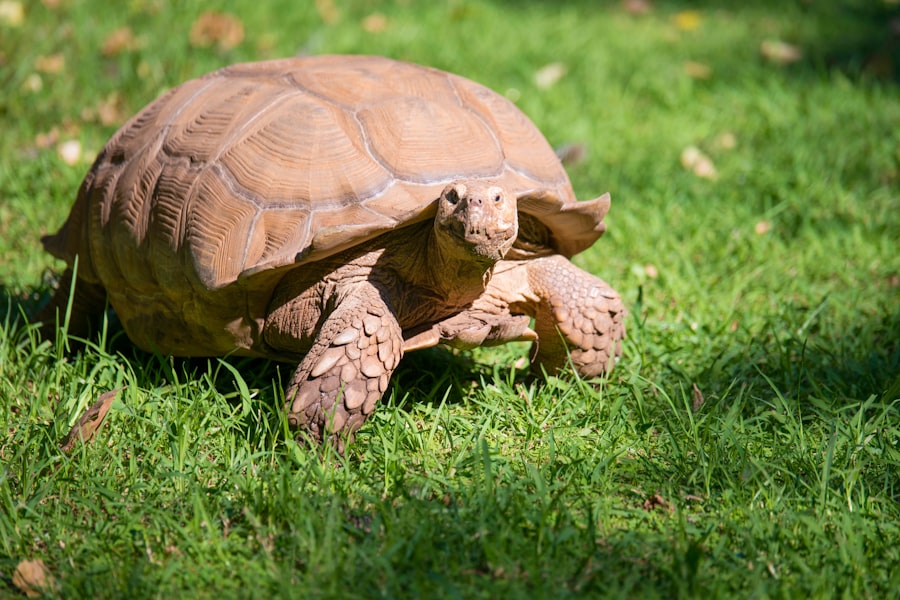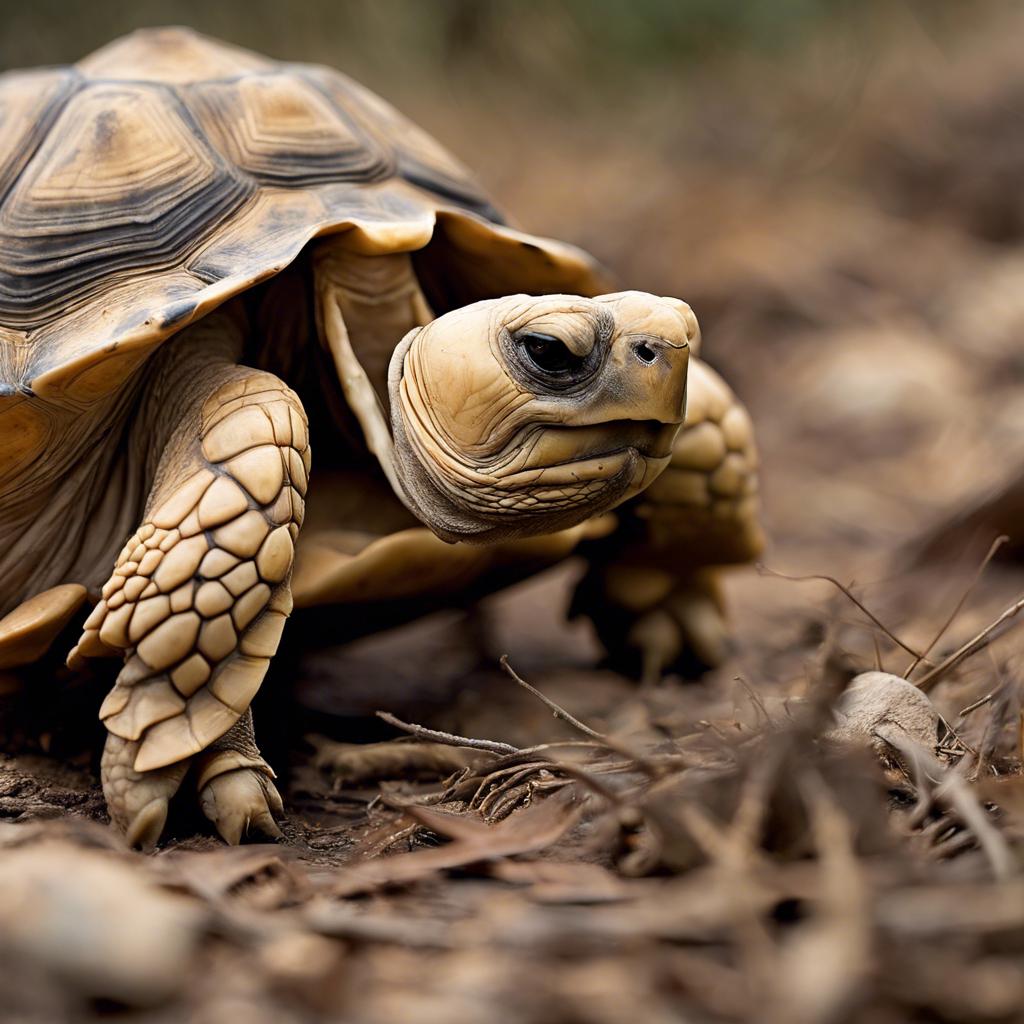Sulcata tortoises, also known as African spurred tortoises, are one of the largest species of tortoises in the world. They are native to the Sahara Desert in Africa and have become popular pets due to their unique appearance and docile nature. However, it is important for potential owners to understand the specific needs of these tortoises, particularly when it comes to their habitat and temperature requirements.
Key Takeaways
- Sulcata tortoises are a popular pet due to their docile nature and longevity.
- These tortoises are native to the Sahara Desert and require a warm and dry environment.
- The ideal temperature range for sulcata tortoises is between 80-100°F.
- Sulcata tortoises can adapt to cold temperatures, but prolonged exposure can lead to health risks.
- To protect sulcata tortoises from cold temperatures, provide a warm and safe environment with heat lamps and insulation.
Understanding the Habitat of Sulcata Tortoises
In the wild, Sulcata tortoises inhabit the arid regions of the Sahara Desert. They are well adapted to this harsh environment, with their large size and thick, scaly skin providing protection from predators and extreme temperatures. They spend most of their time grazing on grasses and other vegetation, and they dig burrows to escape the heat of the day.
When kept in captivity, it is crucial to replicate their natural habitat as closely as possible. This means providing a large enclosure with plenty of space for them to roam and graze. It is also important to provide a substrate that mimics the sandy soil of their natural habitat, as well as hiding spots and a shallow water dish for soaking.
What is the Ideal Temperature Range for Sulcata Tortoises?
Sulcata tortoises are ectothermic animals, which means that they rely on external sources of heat to regulate their body temperature. In their natural habitat, temperatures can reach over 100 degrees Fahrenheit during the day and drop significantly at night. Therefore, it is important to provide a temperature range that allows them to thermoregulate effectively.
The ideal temperature range for Sulcata tortoises is between 80 and 95 degrees Fahrenheit during the day, with a slight drop at night. This can be achieved by providing a basking spot with a heat lamp or ceramic heat emitter, as well as a cooler area for them to retreat to if they become too warm. It is important to monitor the temperature regularly to ensure that it remains within this range.
How Do Sulcata Tortoises Adapt to Cold Temperatures?
While Sulcata tortoises are well adapted to the extreme heat of their natural habitat, they also have some adaptations that allow them to tolerate colder temperatures. For example, they have a high tolerance for low humidity and can withstand dry conditions for extended periods of time. They also have a thick, scaly skin that helps to retain moisture and protect them from the elements.
However, these adaptations have their limitations when it comes to captivity. Sulcata tortoises are not able to tolerate cold temperatures as well as they can tolerate heat. They are susceptible to hypothermia if exposed to prolonged cold temperatures, which can have serious health consequences.
What Are the Risks of Exposing Sulcata Tortoises to Cold Temperatures?
Exposing Sulcata tortoises to cold temperatures can have several health risks. One of the most immediate risks is hypothermia, which occurs when their body temperature drops below a certain threshold. This can lead to lethargy, loss of appetite, and even death if not addressed promptly.
In addition to hypothermia, exposing Sulcata tortoises to cold temperatures can also weaken their immune system and make them more susceptible to respiratory infections and other illnesses. Prolonged exposure to cold temperatures can also lead to long-term health issues such as shell deformities and stunted growth.
How to Protect Sulcata Tortoises from Cold Temperatures?

To protect Sulcata tortoises from cold temperatures, it is important to provide them with a warm and safe environment. This can be achieved by ensuring that their enclosure is properly insulated and providing additional heat sources such as heat lamps or ceramic heat emitters. It is also important to monitor the temperature regularly and make adjustments as needed.
During colder months, it may be necessary to bring Sulcata tortoises indoors or provide them with a heated shelter to protect them from extreme cold. It is also important to provide them with a substrate that retains heat, such as sand or soil, and to avoid placing them on cold surfaces such as concrete or tile.
Tips for Creating a Warm and Safe Environment for Sulcata Tortoises
Creating a warm and safe environment for Sulcata tortoises involves several key considerations. First, it is important to provide a large enough enclosure that allows them to move around freely and engage in natural behaviors such as grazing and digging. The enclosure should also have proper insulation to retain heat and protect them from drafts.
In terms of temperature and humidity, it is important to provide a basking spot with a heat lamp or ceramic heat emitter that maintains a temperature of around 90 degrees Fahrenheit. The cooler area of the enclosure should be kept at around 80 degrees Fahrenheit during the day and drop slightly at night. Humidity levels should be kept relatively low, as Sulcata tortoises are adapted to dry conditions.
What Are the Signs of Hypothermia in Sulcata Tortoises?
Hypothermia is a serious condition that can occur when a Sulcata tortoise's body temperature drops below a certain threshold. It is important to recognize the signs of hypothermia early in order to take appropriate action. Some common symptoms of hypothermia in Sulcata tortoises include lethargy, loss of appetite, shivering, and cold extremities.
If you suspect that your Sulcata tortoise is experiencing hypothermia, it is important to take immediate action to warm them up. Move them to a warmer area or provide additional heat sources such as a heat lamp or heating pad. It is also important to monitor their temperature closely and seek veterinary care if their condition does not improve.
How to Treat Hypothermia in Sulcata Tortoises?
If a Sulcata tortoise is experiencing hypothermia, there are several steps that can be taken to treat the condition. First, move them to a warmer area and provide additional heat sources such as a heat lamp or heating pad. It is important to warm them up gradually to avoid shocking their system.
Once the tortoise has been warmed up, it is important to monitor their temperature closely and provide supportive care such as fluids and electrolytes if necessary. If their condition does not improve within a few hours, it is important to seek veterinary care as soon as possible.
Ensuring the Health and Well-being of Sulcata Tortoises in Cold Weather
In conclusion, it is crucial to understand the specific needs of Sulcata tortoises, particularly when it comes to their habitat and temperature requirements. These tortoises are well adapted to the extreme heat of their natural habitat but are not able to tolerate cold temperatures as well. Exposing them to cold temperatures can have serious health consequences, including hypothermia and weakened immune system.
To ensure the health and well-being of Sulcata tortoises in cold weather, it is important to provide them with a warm and safe environment. This includes providing a large enclosure with proper insulation, as well as additional heat sources such as heat lamps or ceramic heat emitters. It is also important to monitor the temperature regularly and make adjustments as needed.
By taking these steps, owners can help ensure that their Sulcata tortoises remain healthy and thrive in any weather conditions.
If you're interested in learning about the cold tolerance of sulcata tortoises, you might also find our article on “How Cold Can a Sulcata Tortoise Survive?” informative. This article explores the temperature ranges that these fascinating creatures can withstand and provides valuable insights into their natural habitat and care requirements. To delve deeper into this topic, click here.
FAQs
What is a sulcata tortoise?
A sulcata tortoise is a species of tortoise native to the Sahara Desert in Africa. They are also known as African spurred tortoises.
What is the natural habitat of a sulcata tortoise?
Sulcata tortoises are adapted to live in hot and dry environments, such as the Sahara Desert. They are known to burrow underground to escape the heat of the day.
How cold can a sulcata tortoise survive?
Sulcata tortoises are not adapted to survive in cold temperatures. They are most comfortable in temperatures between 75-85°F (24-29°C). They can survive brief periods of temperatures as low as 50°F (10°C), but prolonged exposure to cold temperatures can be fatal.
What happens to a sulcata tortoise in cold temperatures?
When a sulcata tortoise is exposed to cold temperatures, their metabolism slows down and they become lethargic. If the temperature drops too low, they can become hypothermic and their organs can shut down, leading to death.
How can I protect my sulcata tortoise from cold temperatures?
If you live in a colder climate, it is important to provide your sulcata tortoise with a heated indoor enclosure during the winter months. The enclosure should be kept at a temperature between 75-85°F (24-29°C) to ensure their health and well-being.

